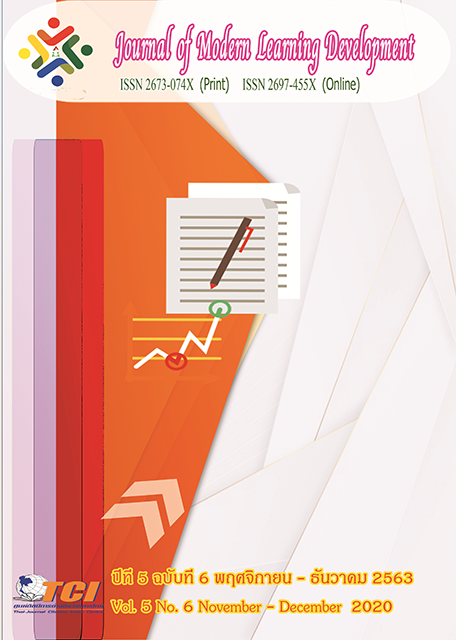The The Improvement of Reading Comprehension of Secondary School Students Using Web-based Instruction and KWL-Plus
Main Article Content
Abstract
The growing of technology had contributed to language learning; especially the use of Web-based instruction (WBI) had been increased in the language classroom. WBI has recognized its’ effects on the students’ language skills such as listening, speaking, writing, and reading. However, technology could not replace teachers in class, for the fact that it was a lack of human interaction and inspiration for the students. The current study attempted to investigate the integration technology and teacher instruction by adopting WBI and KWL- Plus to improve secondary school students reading comprehension at a literal level as well as the students’ attitudes towards WBI and KWL-Plus. The participants were seventh-grade students consisted of twenty students in the secondary school in the Northeast of Thailand. The implementation of the current study lasted eighteen hours. The web-based lesson was designed based on KWL-Plus procedures and scaffolding instruction through web-based instruction. According to data collection, the researcher adopted reading comprehension pretest and posttest, questionnaire, and semi-structured interview. The findings of the study showed that there was a significant difference between the overall mean scores of students reading comprehension pre-test and posttest at the 0.01 level and students expressed a positive attitude towards the integration of Web-based instruction and KWL-Plus at a very high level. In addition, the qualitative data obtained from the semi-structured interview indicated that the majority of the students enjoyed performing reading with the integration of Web-based Instruction and KWL-Plus.
Article Details
References
Abdulkarim, H. A.-N. (2003). The Relationship between Vocabulary Size, Reading Strategies, and Reading Comprehension of EFL Learners in Saudi Arabia. the degree of Doctor of Philosophy : Oklahoma State University.
Arkorful, V., & Abaidoo, N. (2014). The role of e-learning, the advantages and disadvantages of its adoption in Higher Education. International Journal of Education and Research, 2(12), 397–410.
Dehghanpour, E., & Hashemian, M. (2015). Efficiency of Using a Web-Based Approach to Teach Reading Strategies to Iranian EFL Learners. English Language Teaching, 8 (12), 30–41.
Dole, J. A., Brown, K. J., & Trathen, W. (1996). The effects of strategy instruction on the comprehension performance of at-risk students. Reading Research Quarterly, 31 (1) , 62–88.
Gómez, F. A. A., López, D. C., & Marin, L. F. G. (2011). Reading Comprehension in Face-to-Face and Web-Based Modalities: Graduate Students’ Use of Reading and Language Learning Strategies in EFL. Colomb. Appl. Linguist. J., 13(2), 11–28.
Grabe, W., & Stroller, F. (2002). Teaching and researching reading. Reading in a Foreign Language, 14 (2), 155-157.
Likert, R. (1932). A Technique for the Measurement of Attitudes. Archives of Psychology : New York University.
Mohammad, H. H. (2014). KWL-Plus Effectiveness on Improving Reading Comprehension of Tenth Graders of Jordanian Male Students. Theory and Practice in Language Studies, 4(11), 2278–2288.
Moore, G. M., & Kearsley, G. (2011). Distance Education: A Systems View of Online Learning. Cengage Learning: University of New England.
Ogle, D., & Carr, E. (1987). KWL Plus: A strategy for comprehension and summarization. Journal of Reading, 30, (7), 626–631.
Saiyod, P. (2009). Effects of task- based english reading instruction on reading comprehension ability of elementary school students. Bangkok: Chulalongkorn University.
Setyawan, A. (2018). Improving Students’ Reading Comprehension through KWL (Know-Want-Learn) Strategy (A Classroom Action Research at Eight Grade Students of SMP Islam Al- Asmaniyah). Jurnal Asy- Syukriyyah, 19(2), 25–34.
Torki, A. S., Kasmani, B. M., & Valipour, V. (2014). The Effect of Using L1 Reading Comprehension Task on Iranian EFL Learners’ L2 Reading Comprehension Test Score. Asian Journal of Social Sciences & Humanities, 3(2), 37–43.


